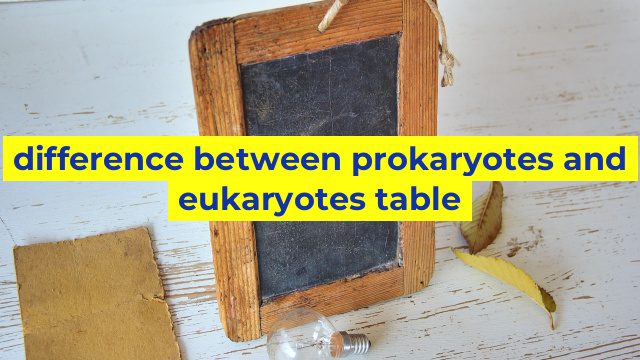The Fundamental Differences Between Prokaryotes and Eukaryotes Table
Prokaryotes and eukaryotes are two different types of cells with distinct characteristics. Although both are cells, they differ in terms of their complexity, structure, and function. In this article, we will discuss the fundamental differences between prokaryotes and eukaryotes in a comparative table.
Prokaryotes
Prokaryotes are unicellular organisms that lack a true nucleus and membrane-bound organelles. They are the simplest form of life and have a relatively simple structure that is not compartmentalized. Here are some of the characteristics of prokaryotic cells:
| Feature | Prokaryotes |
|---|---|
| Nucleus | Absent, nucleoid region present |
| Size | Smaller (1-5 microns) |
| Membrane-bound organelles | Absent |
| Cell division | Binary fission |
| Cytoplasm | Less organized |
| Genetic material | Circular, naked DNA |
Eukaryotes
Eukaryotes, on the other hand, are more complex organisms that have a true nucleus, membrane-bound organelles, and a cytoskeleton. They are multi-cellular organisms and have a more complex structure compared to prokaryotes. Here are some of the characteristics of eukaryotic cells:
| Feature | Eukaryotes |
|---|---|
| Nucleus | Present |
| Size | Larger (10-100 microns) |
| Membrane-bound organelles | Present |
| Cell division | Mitosis and meiosis |
| Cytoplasm | Well-organized |
| Genetic material | Linear, complexed DNA |
Conclusion
In conclusion, prokaryotes and eukaryotes have several distinct features that differentiate them from each other. Prokaryotic cells lack a true nucleus and membrane-bound organelles, while eukaryotic cells have both. Additionally, eukaryotic cells are larger and more complex than prokaryotic cells. Understanding the differences between these two types of cells is crucial in understanding the diversity of life on Earth.
Table difference between prokaryotes and eukaryotes table
| Characteristics | Prokaryotes | Eukaryotes |
|---|---|---|
| Nucleus | No true nucleus; circular DNA located in nucleoid region | True nucleus; DNA enclosed in nuclear membrane |
| Membrane-bound organelles | None | Present |
| Size | Usually smaller (1-10 μm) | Usually larger (10-100 μm) |
| Cell division | Binary fission | Mitosis (for somatic cells) and meiosis (for gamete formation) |
| Cell wall | Present in most prokaryotes; made of peptidoglycan | Present in some eukaryotes; made of cellulose or chitin |
| Motility | May have flagella or pili for movement | May have flagella or cilia for movement |
| Example organisms | Bacteria and Archaea | Plants, animals, fungi, and protists |

